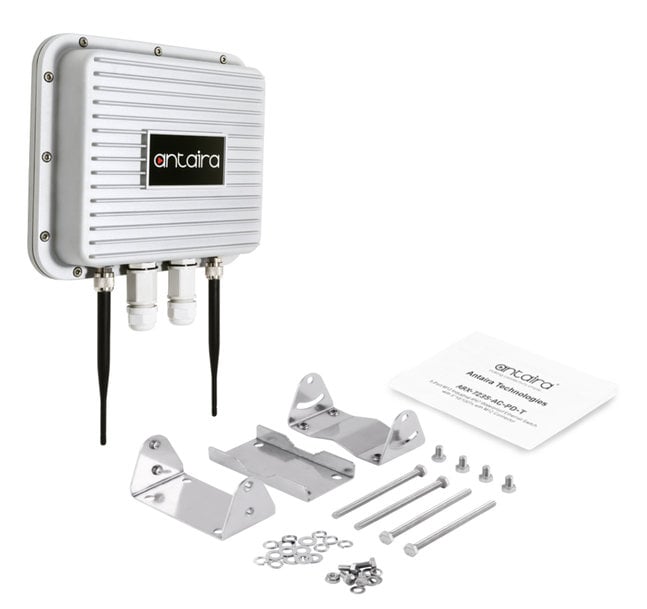www.industryemea.com
16
'23
Written on Modified on
Understanding Network Bridging in Industrial Wireless Distribution Systems
Article by Henry Martel, Field Application Engineer, Antaira Technologies.

The cornerstone of Industrial Wireless Solutions is the Wireless Distribution System (WDS) bridge—a fundamental yet often misunderstood system component. WDS bridges connect multiple networks together and forward traffic between them via Access Points (APs), effectively creating a single, connected, aggregate network over a wireless channel.
Every WDS application will require devices to perform network bridging, whether the goal is to connect data across several subnets within a large industrial facility or link LANS across the internet to a range of physical sites on a corporate campus. This article aims to shed light on what a WDS bridge is and why it plays such a pivotal role in the success of industrial wireless solutions.
Why Industrial WDS is Needed
As any plant manager knows, industrial environments often make it impractical, cost prohibitive or simply impossible to use a traditional wired Ethernet backbone to connect LANs or to expand wireless connectivity. Since the 90s, network administrators have successfully addressed this dilemma by the wireless interconnection of access points in IEEE 802.11 networks. This method of connection, known as WDS, eliminates the hassle, cost and time associated with connections to a wired backbone.
WDS Configuration
In a WDS bridge configuration, one device acts as the main access point and provides clients with a connection to access the wired network. The other APs, which are called the relay stations or remote base stations, connect wirelessly to the main access point (“main base station”) and forward traffic between the main access point and the users and other devices on their respective networks.
The APs are configured in either point-to-point or point-to-multipoint bridge mode, depending on the number of links you require. For instance, in a basic point-to-point connection application, two APs communicate with each other via highly directional antennas that transmit and receive signals through air, allowing two segments of a local area network (LAN) to wirelessly join together. Conversely, when operating in point-to-multipoint bridge mode, a single AP serves as the connection for several access points.
In a point-to-multipoint WDS configuration, the APs must have the same Service Set Identifier (SSID), wireless channel, authentication mode, and security settings. In addition, each of these wireless devices are set to operate in the same LAN IP subnet range. Either the 2.4 GHz band or the 5 GHz band can be used for a wireless bridge, but 2.4 GHz and 5 GHz wireless signal bands cannot be bridged together.
Location of WDS APs is an important factor. Signal strength plays a major role in how quickly a WDS link operates, just like with any other other wireless device, router, switch or LAN equipment. You don't want to further slowdown link speed by placing WDS APs too far apart since each WDS "hop" already cuts potential throughput.
Network access and security is another issue within a wireless network. To restrict access only to authorized personnel, it is necessary to secure connections to the WDS through either wireless encryption protocol (WEP) or wireless protected access (WPA) protocol. WPA and WPA2 are newer, more secure protocols that better protect wireless signals, stations and their related computer networks from unauthorized access.
Antaira WDS Bridge Devices
Wireless distribution system bridges are available as bridging only devices, such as the new and affordable Antaira AMY-5133-AC-PD 802.11 5GHz wireless AP/Client Bridge. In addition, value-adding multifunction devices like the Antaira ARX-7235-AC-PD-T, combine 802.11a/b/g/n/ac Wireless Access Point, Client, Bridge, Repeater, Router, NAT, and VPN with the convenience of being a PoE PD. Both reliable wireless connectivity devices facilitate seamless wireless communication, offering secure and stable wireless bridging, as do several other industrial wireless routers, IoT gateways, wireless access points, clients, and repeaters from Antaira.
Of equal importance are hardened designs that empower you to construct a dependable, high-quality wireless system for WDS in nearly any industrial or environmental condition. All Antaira systems are engineered to endure harsh conditions like extreme temperatures, humidity, vibrations, and electromagnetic interference that would damage standard network devices.
The Antaira ARX-7235-AC-PD-T is designed for industrial and enterprise outdoor wireless access applications. Embedded with the Qualcomm IPQ4029 SoC chipset, it boasts network robustness, stability, and wider network coverage. Based on IEEE 802.11a/b/g/n/ac, the access point supports high-speed data transmission of up to 867Mbps.
www.antaira.com

